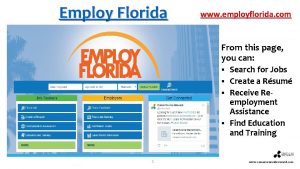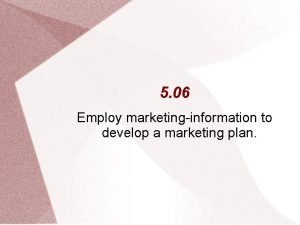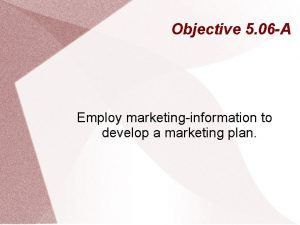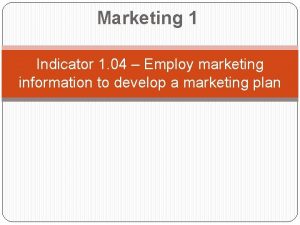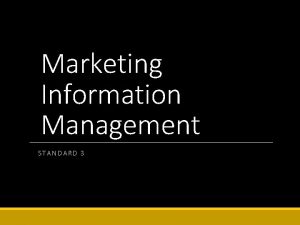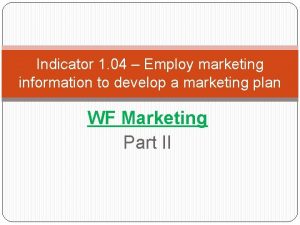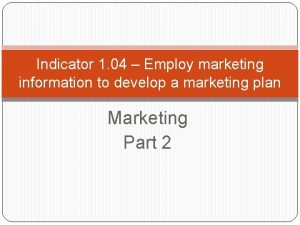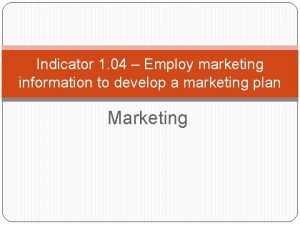Marketing Management Indicator 1 03 Employ marketinginformation to











- Slides: 11

Marketing Management Indicator 1. 03 Employ marketing-information to develop a marketing plan

What is a marketing plan? A written document that specifies how, where, and to whom a business plans to market its products and or brand. It is part of a business’s overall business plan. Used to explain its goals and strategies Can be used to introduce new products, enter new target markets, or new strategies.

Facts about marketing plans Created by big and small businesses Many people read the plan (department, upper management, investors etc) Involves a lot of time, effort, and research to create

Benefits of a marketing plan Defines the goals. ◦ Set goals are easier to remember, stick to, measure, and achieve. ◦ Helps unite business towards common goals. Encourages team work. Provide direction in organization ◦ Clear direction is provided for everyone Understand target market(s) better ◦ No success unless the customers’ needs and wants are met. Planning marketing strategies with more precision ◦ Helps coordinate activities and determine which strategies to use

Benefits of a marketing plan Tracking progress more effectively ◦ Can track progress in a measurable way Understand past marketing decisions and outcomes better ◦ Allows the opportunity to look back and see what strategies worked well—and didn’t Obtain funding ◦ Potential investors will want to see a plan before putting money into a business.

Marketing Plan Facts Not every plan looks the same Formats will vary depending on organizational needs Most businesses include the following sections in their plan:

Components of a marketing plan Executive summary Situation/SWOT analysis Desired target market Marketing objectives Marketing strategies and programs Financial plans Performance and Implementation Appendix

Purpose of marketing plan components Executive summary ◦ Serves as an introduction to the marketing plan ◦ Allows the reader to understand the purpose of the marketing plan ◦ It is an outline of the plan and addresses the most important points ◦ Provides company background information and the mission statement. ◦ **May be the only part that some people ever read Situation/SWOT analysis ◦ Determines firm’s current marketing situation ◦ Answers the basic question of “Where do things stand right now? ” ◦ Serves as a snapshot of the business’s current state of affairs as related to marketing

Situation/SWOT analysis Looks at the following areas: The company itself ◦ Goals, goods/services, financial situation Customers (target market) ◦ Size, demographics, purchasing behaviors Competitors ◦ Market position, strengths/weaknesses Partners ◦ Distributors/Suppliers External factors ◦ Trends, social/ cultural, technology, economics, politics A SWOT analysis chart – strengths, weaknesses, opportunities, and threats.

Desired Target Market ◦ Demographic description ◦ Wants/ Needs of target market and How much will they pay ◦ What message will we send them Marketing objectives ◦ Outlines the specific marketing objectives that the company wants to accomplish ◦ Should be SMART- specific, measurable, achievable, realistic, and time-bound. ◦ This section also discusses any issues that might make it difficult to meet the objectives. Marketing strategies and programs ◦ Heart of the marketing plan, longest section ◦ Identifies the general marketing strategy such as growth, stability ◦ Also discusses schedules, timetables, responsibilities ◦ All aspects of product, place, price, promotion

Purpose of marketing plan components Financial plans ◦ Provides details on the expected expenses and profits Performance and Implementation plan ◦ Give expected results and indicates how the plans’ progress will be measured ◦ Describes potential changes and adjustments that can be made to keep the plan on track. Appendix ◦ Holds charts, graphs, or miscellaneous materials related to the plan
 Employment florida marketplace
Employment florida marketplace Employ florida account
Employ florida account Hunger games districts industries
Hunger games districts industries How does antony show himself to be ruthless in this scene?
How does antony show himself to be ruthless in this scene? Employflorida.com
Employflorida.com Employ florida marketplace
Employ florida marketplace Placators
Placators Employ florida marketplace
Employ florida marketplace Employ
Employ Employ hand grenades
Employ hand grenades How did tycho brahe and kepler employ the scientific method
How did tycho brahe and kepler employ the scientific method Swin employ
Swin employ




